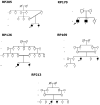Genetic analysis of Indian families with autosomal recessive retinitis pigmentosa by homozygosity screening
- PMID: 19339744
- PMCID: PMC2777646
- DOI: 10.1167/iovs.09-3479
Genetic analysis of Indian families with autosomal recessive retinitis pigmentosa by homozygosity screening
Abstract
Purpose: To identify the disease-causing genes in families with autosomal recessive RP (ARRP).
Methods: Families were screened for homozygosity at candidate gene loci followed by screening of the selected gene for pathogenic mutations if homozygosity was present at a given locus. A total of 34 families were included, of which 24 were consanguineous. Twenty-three genes were selected for screening. The presence of homozygosity was assessed by genotyping flanking microsatellite markers at each locus in affected individuals. Mutations were detected by sequencing of coding regions of genes. Sequence changes were tested for presence in 100 or more unrelated normal control subjects and for cosegregation in family members.
Results: Homozygosity was detected at one or more loci in affected individuals of 10 of 34 families. Homozygous disease cosegregating sequence changes (two frame-shift, two missense, and one nonsense; four novel) were found in the TULP1, RLBP1, ABCA4, RPE65, and RP1 genes in 5 of 10 families. These changes were absent in 100 normal control subjects. In addition, several polymorphisms and novel variants were found. All the putative pathogenic changes were associated with severe forms of RP with onset in childhood. Associated macular degeneration was found in three families with mutations in TULP1, ABCA4, and RP1 genes.
Conclusions: Novel mutations were found in different ARRP genes. Mutations were detected in approximately 15% (5/34) of ARRP families tested, suggesting involvement of other genes in the remaining families.
Figures




Similar articles
-
Mutations in TULP1, NR2E3, and MFRP genes in Indian families with autosomal recessive retinitis pigmentosa.Mol Vis. 2012;18:1165-74. Epub 2012 May 4. Mol Vis. 2012. PMID: 22605927 Free PMC article.
-
Homozygosity Mapping in Leber Congenital Amaurosis and Autosomal Recessive Retinitis Pigmentosa in South Indian Families.PLoS One. 2015 Jul 6;10(7):e0131679. doi: 10.1371/journal.pone.0131679. eCollection 2015. PLoS One. 2015. PMID: 26147992 Free PMC article.
-
A homozygosity-based search for mutations in patients with autosomal recessive retinitis pigmentosa, using microsatellite markers.Invest Ophthalmol Vis Sci. 2004 Dec;45(12):4433-9. doi: 10.1167/iovs.04-0544. Invest Ophthalmol Vis Sci. 2004. PMID: 15557452
-
Identification of recurrent and novel mutations in TULP1 in Pakistani families with early-onset retinitis pigmentosa.Mol Vis. 2012;18:1226-37. Epub 2012 May 10. Mol Vis. 2012. PMID: 22665969 Free PMC article.
-
Identification of the RP1 and RP10 (IMPDH1) genes causing autosomal dominant RP.Adv Exp Med Biol. 2003;533:1-11. doi: 10.1007/978-1-4615-0067-4_1. Adv Exp Med Biol. 2003. PMID: 15180241 Free PMC article. Review. No abstract available.
Cited by
-
Identification of a novel nonsense mutation in RP1 that causes autosomal recessive retinitis pigmentosa in an Indonesian family.Mol Vis. 2012;18:2411-9. Epub 2012 Oct 3. Mol Vis. 2012. PMID: 23077400 Free PMC article.
-
Phenotypic heterogeneity in family members of patients with retinitis pigmentosa.Indian J Ophthalmol. 2023 Jun;71(6):2504-2511. doi: 10.4103/ijo.IJO_1853_22. Indian J Ophthalmol. 2023. PMID: 37322671 Free PMC article.
-
Pathogenic mutations in TULP1 responsible for retinitis pigmentosa identified in consanguineous familial cases.Mol Vis. 2016 Jul 16;22:797-815. eCollection 2016. Mol Vis. 2016. PMID: 27440997 Free PMC article.
-
Comprehensive molecular diagnosis of 179 Leber congenital amaurosis and juvenile retinitis pigmentosa patients by targeted next generation sequencing.J Med Genet. 2013 Oct;50(10):674-88. doi: 10.1136/jmedgenet-2013-101558. Epub 2013 Jul 11. J Med Genet. 2013. PMID: 23847139 Free PMC article.
-
Mutations in TULP1, NR2E3, and MFRP genes in Indian families with autosomal recessive retinitis pigmentosa.Mol Vis. 2012;18:1165-74. Epub 2012 May 4. Mol Vis. 2012. PMID: 22605927 Free PMC article.
References
-
- Bunker CH, Berson EL, Bromley WC, Hayes RP, Roderick TH. Prevalence of retinitis pigmentosa in Maine. Am J Ophthalmol. 1984;97(3):357–365. - PubMed
-
- Xu L, Hu L, Ma K, Li J, Jonas JB. Prevalence of retinitis pigmentosa in urban and rural adult Chinese: The Beijing Eye Study. Eur J Ophthalmol. 2006;16(6):865–866. - PubMed
-
- Hayakawa M, Matsumura M, Ohba N, et al. A multicenter study of typical retinitis pigmentosa in Japan. Jpn J Ophthalmol. 1993;37(2):156–164. - PubMed
-
- Haim M. Prevalence of retinitis pigmentosa and allied disorders in Denmark. III. Hereditary pattern. Acta Ophthalmol (Copenh) 1992;70(5):615–624. - PubMed
Publication types
MeSH terms
Substances
Grants and funding
LinkOut - more resources
Full Text Sources

